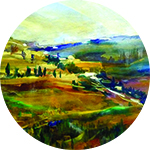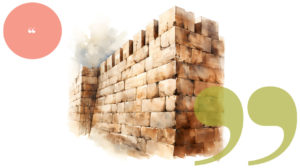From Humdrum to Happy

The challenge: infusing these days with joy!

O h those endless winter days! As the weather cools and the days grow dark we may grow weary of juggling our hectic and exhausting routine of home obligations jobs school meetings and community functions. The challenge: infusing these days with joy!
Rav Shlomo Wolbe in his Alei Shur invests an extensive amount of thought and prose in what he deems his “last and most dear chapter”: simchah! The beginning and end of all Divine service Rav Wolbe says is simchah. As we proceed to evaluate simchah we will better understand the import of his words.
In a recent article on Aish.com writer Shelly Fenig focuses on the prefix that is often attached to Cheshvan: “mar ” bitter. The message of Marcheshvan? Take the mar and become ram — elevated. But how to do this? How to find the extraordinary in the ordinary?
Boiling Out the Bitter
Let’s turn our culinary curiosity to a gemara in Beitzah (25b) which mentions a fascinating legume called the turmus. The turmus Rashi explains was a very bitter bean that needed to be cooked seven times to get rid of its sharp taste. After all those cooking cycles though it became “matok vatov” — sweet and good! It was a delicacy to enjoy as a dessert. Today we know the turmus as the lupine bean a food that must be repeatedly cleaned boiled and refrigerated for at least five days until its brine is no longer bitter.
Is it possible to take what seems to be sour or unsweetened in our lives and create something that can be enjoyed?
So much in life needs to be cleansed in our minds boiled out of our hearts and cooled down to a more positive perspective in order for us to enjoy it. The avodah of simchah is truly that: It is an avodah it is toil but as Dovid Hamelech encourages us (Tehillim 128:2) “When you eat the labor of your hands you are praiseworthy and it is well with you.”
Many situations and encounters in life require this cleansing process. We can often cool down from anger and upset by some deep breathing. There are times however when the pain in our hearts is much too bear. It’s then that we must truly work — work on understanding ourselves our feelings and how we can control and redirect them using our minds.
Just as we can’t recognize patterns or solve puzzles without insight and intelligence we also can’t achieve true simchah without deeper perception of our actions. We all strive for harmony within ourselves yet our lives are often in emotional physical and spiritual turmoil. Our job is to examine our lives: What do I have? Whom do I have? What do I do? How can I connect all of that to a greater purpose?
Mind over Man a fantastic sefer written by Rabbi Yehuda Kielson based on Rav Yechiel Perr’s vaadim in Sefer Madreigas Ha’Adam discusses our “hard work” in improving our lives. In contrasting the tzaddik and the rasha Rav Perr quotes directly from Sefer Madreigas Ha’Adam: “It is essential to know what preceded and what followed. Was the good born from the truth or the truth born from the desire?”
Noble Motivations?
Our motivations walk hand in hand with our actions. A tzaddik knows the reason for his choices. Since his choices are all deliberate born of his inherent emes he is able to cultivate the geshmak that he gets from his life. In contrast a rasha follows his heart before his mind. His whims and lust enable him helping him justify his actions by convincing him that they have a noble purpose.
Rav Perr cites an example of the many runners “attempting to outrun the Malach Hamaves ” whom we can find huffing and sweating in the early morning in every neighborhood. Granted a percentage are sincerely doing this for their cardiac health and their overall physical and emotional wellbeing. They’re motivated by the desire to be able to serve HaKadosh Baruch Hu to the maximum of their abilities.
Everyone else claims to have those same noble motivations. They work toward their goal their commitment seen in their willingness to run in cold and the rain. Yet if a mirror were placed before them we would see their true desire reveal itself. Most are simply concerned with looking attractive. How will I look in that outfit? How will people see me? Where will I stand in society?
We must work Rav Perr explains to build ourselves “a retreat in our hearts away from the insanity.” We must command our minds to direct our instincts and not the reverse. As Torah-true Jews we can direct our minds to the value of every aspect of our lives — be it car pool laundry bills or traffic — in service to Hashem. When we focus on the true meaning and purpose of these mundane tasks serving HaKadosh Baruch Hu will bring us joy.
Tehillim (24) enjoins us “Taamu u’reu ki tov Hashem — taste and see that Hashem is good.” We can use our minds to find the “taam ” the taste in our day-to-day lives. True it is a process of focus and effort — but the dividend is a life full of happiness!
In his Selected Speeches Rav Shimon Schwab quotes the master talmid chacham and Hebrew linguist Rav Samson Raphael Hirsch who notes that the word avel mourner shares the same exact letters in the same exact order as the word aval but. In Rav Hirsch’s world of phonetic cognates this is nary a happenstance. Rather the words’ similarities teach us that the feeling of desperation that comes from lack is the avel that results from the aval. I would be happy in my life but this is missing this happened this challenges me.
A child is born with a natural tendency to be happy. As the years creep on and the child gains self-awareness he begins to notice others. His roving eyes and jealous heart wreak havoc with that original innate happiness. Simchah which was once the natural basis of all his behavior has become an avodah a job.
Navigating Toward Simchah
One can compare simchah to the stars in the sky; they sparkle but we can only see them in the blackened night sky if we lift our eyes toward heaven. It is no coincidence that the challenge of the dreary fall and winter months is always coupled with longer nights. Chanukah can be likened to that bright light of Polaris the northern star that ancient mariners used to steer their ships at night. It is just when we are lost and alone in need of navigation that Chanukah comes reminding us to sharpen our vision and reorient ourselves in Divine service.
As we reach for the stars gaining a deeper understanding of simchah will help us hone our navigation skills. Simchah Rav Wolbe says is created by two opposites colliding in harmony: Think of body and soul man and woman heaven and earth. And what leads to the greatest of all simchahs? Human connection with our Creator — the simchah born from a mitzvah!
The simchah of physical pleasure is easy to attain but is ephemeral in its existence. The simchah of a mitzvah is lasting and mature. It comes from joining our physical drives with what our neshamah strives for. It’s the simchah that grows through diligent thought and a heart driven to serve Hashem.
When we apply introspection and focus to our actions we invest them with joy saturating our life with a happiness that emanates from our neshamos.
“Ivdu es Hashem b’simchah — serve Hashem with joy.” (Tehillim 100) This is Dovid Hamelech’s credo of life and that of every eved Hashem. Those who view every moment and every action as part of their service of Hashem will always be happy.
Originally featured in Family First Issue 567. Rebbetzin Aviva Feiner is the rebbetzin of Congregation Kneseth Israel (The White Shul) and menaheles of Machon Basya Rachel Seminary both in Far Rockaway New York.
Oops! We could not locate your form.











